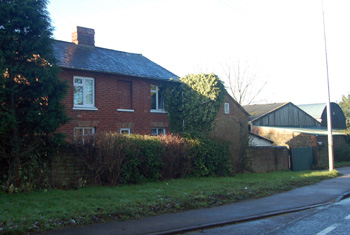
Checkleywood Farm January 2008
Checkleywood Farmhouse lies on the A5, Watling Street. When Heath and Reach was inclosed in 1841 the land that would form the basis of Checkleywood Farm, 69 acres 3 roods mostly in Middle Field, bounded north-east by Watling Street and South by Eastern Way (then simply called a new road to Heath and Reach), was allotted to Thomas Sayell [ABookN]. At that date there was no farmhouse. In 1884 the farm was put up for sale by auction [BML10/30/9]. It then contained 80 acres 3 roods divided as follows:
- Ridge Hill Close - arable - 28 acres 3 roods;
- Craft Close - arable - 17 acres 3 roods;
- Puddles Close - arable - 13 acres;
- Forty Mile Field - grass - 11 acres;
- Home Field, homestead and garden - 4 acres 20 poles;
- Checkley's Wood - grass - 6 acres 2 roods 20 poles
The sale particulars noted: "The Land contains Valuable BEDS OF SILVER SAND, which may be worked with comparatively little expense, being within 12 feet of the surface, and running to a depth of upwards of 20 feet". They further noted: "The whole of the Enclosures, with the exception of Ridge Hill, have a frontage to a good hard Road, the Estate being bounded on one side by the London Road, and on the other by the New Road to Heath and Reach".
The house was described as being built of brick and slate with three rooms downstairs and four above, with an adjoining brick and slate lean-to granary, with a dairy beneath. The farmyard was described as: "(Fenced from the Road by a Brick wall, and approached by a Pair of Folding Doors), in which are the following convenient Buildings, viz: - Large Threshing Barn, with Planked Floor, a two-Bay Shed, Pigsty and Shed, Stable for Four Horses and Chaff-house, Wood Barn and Fowl House; also an Open Shed and Implement Hovel in Home Field, all of which are Timber-built and Thatched". The farm was purchased by George Swinstead for £3,300.

Checkleywood farm land in 1884 and 1888 - the yellow is land of 1884 the blue land added by 1888
Just four years later the farm was again for sale, by Thomas and George Belgrove Swinstead, along with other property, including the Globe Inn, Old Linslade. The farm then contained 122 acres 32 poles. The additional land was accounted for by two enclosures of pasture land totalling 41 acres 1 rood 32 poles. The farm had a reserve of £3,500 and was not sold.
The Rating and Valuation Act 1925 ordered every piece of land and building in the country to be assessed to determine the rates to be paid on them. Heath and Reach was valued in 1927 and the valuer visiting Checkleywood Farm [DV1/H31/4] noted that it was then owned by local sand quarrying firm George Garside and Son and occupied by William Freeman. Directories show that Freeman had been in occupation since at least 1910 and would continue as occupier until at least 1931.
The rent for the farm was £160, the same as it had been before the First World War. In 1914 the farm had comprised 171 acres, showing that more land had been added, but by 1927 this had shrunk to 160 acres. One can guess that this was because eleven acres had been opened up for sand quarrying. The valuer noted that, instead of the mixture of arable and grass of the 1880s it was now "all cow land".
The farmhouse, built of brick and slate, comprised one large room, one reception room, a kitchen and cellar ("was dairy" - the lean-to structure noted in 1884) downstairs with four bedrooms above. A brick and tile cooling house and dairy stood outside. The homestead comprised: a brick and slate granary; a brick, wood and tile stable and coachhouse ("new"; "good"); a brick and corrugated iron piggery and cow house for four beasts; a brick, wood and corrugated iron barn and cow house for six beasts with a feeding hovel inside; a cow house for two beasts and a stone and corrugated iron cow house for nine beasts. In the meadow stood three wood and corrugated iron cattle sheds and a wood and corrugated iron open fronted shed. Kelly's Directory for 1940 notes that the occupier was then W. G. Shirley.